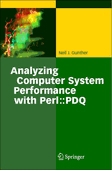PDQ in Perl 5
PDQ in Perl 5
This page was last updated on Aug 31, 2008
Contents
1 Release Information
2 Power of Perl
3 User Guide
4 Feedback
1 Release Information
This page concerns the Perl 5 latest release of
PDQ
which also accompanies the book:

Once you have
downloaded
the PDQ distribution and installed it (per these
instructions),
you will find the Perl PDQ models located in the
../examples/ppdq_2005/pdq_models/
directory. A detailed synopsis of how to use the Perl version of PDQ can be found in
Chapter 6 of the above book. Other Perl (non-PDQ) codes used in the book, can be found in the
../examples/ppdq_2005/perl_examples/
directory.
2 Power of Perl
I just did it again! I needed to extract some performance data from a file and feed it into
a PDQ model. It took me 2 minutes to write the
Perl code
and apply it successfully. I couldn't
even write the C-code in 2 minutes, let alone compile it, debug it and apply it successfully.
This is the point that
John Ousterhout
(father of Tcl) tries to make. Much of what he has to say also applies
to computer performance modeling. I say more about this in the Preface of my
Performance with Perl::PDQ
book.
Some more reasons to consider using Perl PDQ (rather than the C version) are:
- The Perl interpreter is ubiquitous, being available by default on most
UNIX and Linux systems.
- Perl syntax is very similar to C syntax.
- Perl comes with an integrated debugger.
- You no longer need to explicitly compile and link each PDQ model.
- Since the historical roots of Perl run deep in text processing, it is
eminently suited to extracting (the `e' in Perl) data out of files e.g.,
performance data that may already be residing in log files or other databases.
Such data can be extracted, filtered and used to parameterize PDQ models, all within the
same Perl code.
The conversion of the C source to Perl was performed entirely by
Peter Harding
using the
SWIG
facility.
In the future, we hope to incorporate some of your own Perl PDQ models on this page.
See the section below on sending Feedback if you have a submission.
3 User Guide
An instruction manual for building Perl-PDQ models appears as a chapter in the
new book
but you may download a
preview copy
now.
4 Feedback
New versions of Perl-PDQ are released periodically. Please fill out this
form
if you would like to notified by email when the release occurs. We are also
interested to hear from you if you have Perl code or ideas to contribute to future releases.
File translated from
TEX
by
TTH,
version 3.38.
On 31 Aug 2008, 08:43.
